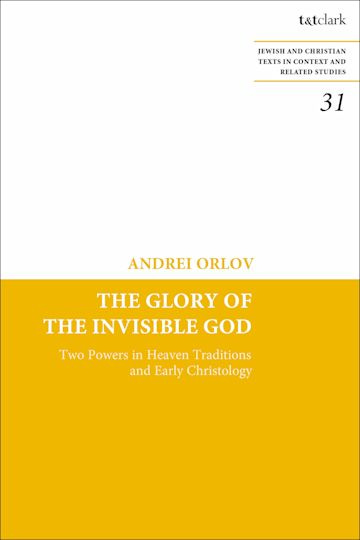Andrei Orlov
The Glory of the Invisible God: Two Powers in Heaven Traditions and Early Christology. London: T&T Clark, 2019. 40.00$ USD.
I wish I had discovered the various works of Dr. Andrei Orlov earlier as he has produced some stimulating pieces of research about intermediary figures, angels, heavenly doppelgangers, and even supernatural serpents, with a particular expertise on Jewish and Christian pseudepigrapha and Hekhalot materials.
In this volume, Orlov picks up the mantle from the late Alan Segal and maps out the origins of the “two powers” theology in relation to Jewish and Christian perspectives about the transference of the divine glory in a second power. Orlov furthers the case, first intimated in his earlier volume on Yahoel and Metatron, that traditions about the two powers in heaven often portray the second power as a visual manifestation of the divine Kavod, which provides something of an analogue for discourses of Jesus’s divinity in early Christianity even within the constraint of Jewish monotheism. In particular, Orlov contends that a pattern emerges in narratives whereby the first power withdraws from the scene, is then known only through aniconic aural phenomenon like a voice, while the ocular manifestation of the divine glory is then located in the second power who exhibits a celestial/angelic form.
He finds this pattern helpful in explaining features found in Jewish and Christian angelology, pneumatology, and Christology. The scheme posits the existence of a “novel mediator without assigning an exclusive divine status to this agent” (7).
The book breaks down into two parts covering Jewish and Christian instances of two powers in heaven accounts.
In part one, examining Jewish accounts, Orlov surveys a number of texts and traditions including Daniel 7, Enochic Similitudes, Primary Adam Books, the Exagoge, 2 Enoch, Ladder of Jacob, and angelic opposition to YHWH, which show the evolution of theophanic imagery whereby the ocularcentric aspects of the first power were steadily transferred to a second power who posseses the divine glory and becomes an image or visual icon of the deity. According to Orlov, Daniel provides something of a template of a second power invested with divine glory, who is very much aligned with the first heavenly power (unlike rabbinic accounts where the second power is often in polemical opposition to the first power). The Son of Man in the Similitudes also absorbs several features of the divine glory, in particular, when seated upon a “throne of glory.” This is indicative of the trope of the “gradual endowment of the second power with attributes of the deity but also the first power’s steady abandonment of its previous roles and functions” (20). Similar patterns are detected in a variety of other Jewish writings that deal with elevated intermediary figures that become anthropomorphic manifestations of divine glory, power, and kingship.
In part two, examining Christian accounts, Orlov pays particular attention to scenes in the Synoptic Gospels pertaining to Jesus’s transfiguration, baptism, and temptations as instances of the glorification of a second power as the visible manifestation of the deity. For me, this was a very interesting choice, as I would have thought that 1 Cor 8:6 and Phil 2.6-11 would be the main exemplars for the pattern that Orlov attempts to identify in early christological discourse, yet these texts were not examined. Orlov follows scholars like Carey Newman and Andrew Chester who seek to unpack the significance of Jesus described as the “Lord of glory” in early Christian texts (e.g., 1 Cor 2:8) which Orlov takes as an instance of a pattern of a second figure becoming endowed with the ocularcentric features of divinity. In the transfiguration scene, Jesus is arrayed in divine glory, while God is revealed only as the voice from heaven, exemplifying Orlov’s point about two discrete theophanic modes of epiphany, aural an ocular. In the baptism scene, Jesus is portrayed as the embodiment and restorer of the divine image, who received divine glory in the form of a descending dove, while God is again known only through the heavenly voice. The arguments about these periocpae are constructed with close attention to the text, detecting various intertextual allusions to Sinai traditions, Ezekiel, and Daniel, comparisons with other Jewish traditions about divine glory and second power, and with occasional referrals to patristic exegesis.
The study is well-argued and well-researched, even though I would quibble over a few things. While the two-powers theology has precedents in Philo, maps onto hekhalot literature and rabbinic anti-heretical writings, and has a certain analogue with primitive christological discourses, nonetheless, my reservations are: (1) Segal himself was rather circumspect as to whether a mature two-powers theology had traction in the first-century; and (2) The utility of Orlov’s scheme for explaining the origins and impetus for christological affirmations of Jesus’s divine status may not work so cleanly or neatly when applied to early Christian texts. I would add too that some proposals he makes are open to alternative explanations. For instance, the dove in the Synoptic baptism scene could be, as Orlov argues, an instance of “Pteromorphic Glory,” or else with Michael Peppard one could see the dove as a deliberate counter-part to the Roman eagle, a symbol of imperial power. It simply depends on which textual background or which comparator the materials are set beside.
In any case, this is a very learned volume, with a sophisticated grasp of the primary sources, and the footnotes are replete with quotations from secondary literature that buttress the assertions that are made. Orlov has provided a thought-provoking thesis that explains how a second power could be identified with the divine qualities, authority, and attributes of the first divine power. I find the thesis intriguing and I would love to see Dr. Orlov explain how his pattern of aural/oracular epiphany applies to something like the Book of Revelation, especially the transition from Revelation 4 to Revelation 5. But that might be something we might hope to read from him in the future.





I'd never heard of this idea. Thanks for sharing!